Spatial Heterogeneity of Soil Nutrient in Principal Paddy and Cereal Production Landscapes of Fengtai County within the Huai River Basin, Eastern China
Abstract
:1. Introduction
2. Materials and Methods
2.1. Study Area Description
2.2. Sample Collection and Analysis
2.3. Statistical and Geostatistical Methods
2.3.1. Geostatistical Analysis
2.3.2. Spatial Autocorrelation Analysis
2.3.3. Spatial Clustering Analysis
2.4. Soil Quality Assessment
2.4.1. Minimum Data Set Construction
2.4.2. Construction of Soil Quality Scoring Method
2.4.3. Soil Index Weight and SQI Calculation
2.5. Data Processing
3. Results and Analysis
3.1. Descriptive Statistics of Soil Nutrients
3.2. Spatial Distribution Characteristics of Soil Nutrients
3.2.1. Determination of the Best Geostatistical Fitting Model
3.2.2. Soil Nutrient Spatial Distribution Status
3.3. Spatial Variability of Soil Nutrients
3.3.1. Geostatistical Analysis of Soil Nutrients
3.3.2. Spatial Autocorrelation Analysis of Soil Nutrients
3.3.3. Spatial Clustering Analysis of Soil Nutrients
3.4. Assessment of Soil Fertility Status
3.4.1. Selection of Soil Indicators for the Minimum Data Set
3.4.2. Indicator Scores and Weights
4. Discussion
4.1. Characterization of Nutrient Variation and Recommendations for Zoning Management
4.2. Research Innovations and Ideas for Improvement
4.3. Assessment of Soil Fertility Quality Status
5. Conclusions
Author Contributions
Funding
Data Availability Statement
Conflicts of Interest
References
- Haq, S.M.; Hassan, M.; Jan, H.A.; Al-Ghamdi, A.A.; Ahmad, K.; Abbasi, A.M. Traditions for future cross-national food security—Food and foraging practices among different native communities in the Western Himalayas. Biology 2022, 11, 455. [Google Scholar] [CrossRef] [PubMed]
- Bogunovic, I.; Trevisani, S.; Seput, M.; Juzbasic, D.; Durdevic, B. Short-range and regional spatial variability of soil chemical properties in an agro-ecosystem in eastern Croatia. Catena 2017, 154, 50–62. [Google Scholar] [CrossRef]
- Rinot, O.; Levy, G.J.; Steinberger, Y.; Svoray, T.; Eshel, G. Soil health assessment: A critical review of current methodologies and a proposed new approach. Sci. Total Environ. 2019, 648, 1484–1491. [Google Scholar] [CrossRef] [PubMed]
- Socher, S.A.; Prati, D.; Boch, S.; Müller, J.; Klaus, V.H.; Hölzel, N.; Fischer, M. Direct and productivity-mediated indirect effects of fertilization, mowing and grazing on grassland species richness. J. Ecol. 2012, 100, 1391–1399. [Google Scholar] [CrossRef]
- Jiang, Z.; Zhou, Y.; Chen, D. Effects of microbial fungicide and soybean straw biochar on nutrients and quality of Brassica napus in black soil of sand ginger. China Melon Veg. 2024, 37, 133–139. [Google Scholar] [CrossRef]
- Waring, B.G.; Álvarez-Cansino, L.; Barry, K.E.; Becklund, K.K.; Dale, S.; Gei, M.G.; Keller, A.B.; Lopez, O.R.; Markesteijn, L.; Mangan, S.; et al. Pervasive and strong effects of plants on soil chemistry: A meta-analysis of individual plant ‘Zinke’ effects. Proc. R. Soc. B Biol. Sci. 2015, 282, 20151001. [Google Scholar] [CrossRef] [PubMed]
- Long, L.; Liu, Y.; Chen, X.; Guo, J.; Li, X.; Guo, Y.; Zhang, X.; Lei, S. Analysis of spatial variability and influencing factors of soil nutrients in western China: A Case Study of the Daliuta Mining Area. Sustainability 2022, 14, 2793. [Google Scholar] [CrossRef]
- Samuel, A.D.; Bungau, S.; Tit, D.M.; Melinte, C.E.; Purza, L.; Badea, G.E. Effects of long term application of organic and mineral fertilizers on soil enzymes. Rev. Chim. 2018, 69, 2608–2612. [Google Scholar] [CrossRef]
- Florinsky, I.V.; Eilers, R.G.; Lelyk, G.W. Prediction of soil salinity risk by digital terrain modeling in the Canadian prairies. Can. J. Soil Sci. 2000, 80, 455–463. [Google Scholar] [CrossRef]
- Kral, F.; Corstanje, R.; White, J.R.; Veronesi, F. A geostatistical analysis of soil properties in the Davis Pond Mississippi freshwater diversion. Soil Sci. Soc. Am. J. 2012, 76, 1107–1118. [Google Scholar] [CrossRef]
- Fu, W.; Dong, J.; Ding, L.; Yang, H.; Ye, Z.; Zhao, K. Spatial correlation of nutrients in a typical soil-hickory system of southeastern China and its implication for site-specific fertilizer application. Soil Tillage Res. 2022, 217, 105265. [Google Scholar] [CrossRef]
- Thakur, N.; Sharma, R.; Kumar, A.; Sood, K. Soil fertility appraisal for pea growing regions of Himachal Pradesh using GPS and GIS techniques. Indian J. Agric. Res. 2021, 55, 452–457. [Google Scholar] [CrossRef]
- Liu, Y.; Chen, Y.; Wu, Z.; Wang, B.; Wang, S. Geographical detector-based stratified regression kriging strategy for mapping soil organic carbon with high spatial heterogeneity. Catena 2021, 196, 104953. [Google Scholar] [CrossRef]
- Mishra, U.; Hugelius, G.; Shelef, E.; Yang, Y.; Strauss, J.; Lupachev, A.; Harden, J.W.; Jastrow, J.D.; Ping, C.L.; Riley, W.J.; et al. Spatial heterogeneity and environmental predictors of permafrost region soil organic carbon stocks. Sci. Adv. 2021, 7, eaaz5236. [Google Scholar] [CrossRef]
- Chen, S.; Lin, B.; Li, Y.; Zhou, S. Spatial and temporal changes of soil properties and soil fertility evaluation in a large grain-production area of subtropical plain, China. Geoderma 2020, 357, 113937. [Google Scholar] [CrossRef]
- Wang, R.; Zou, R.; Liu, J.; Liu, L.; Hu, Y. Spatial distribution of soil nutrients in farmland in a hilly region of the pearl river delta in China based on geostatistics and the inverse distance weighting method. Agriculture 2021, 11, 50. [Google Scholar] [CrossRef]
- Yan, P.; Peng, H.; Yan, L.; Zhang, S.; Chen, A.; Lin, K. Spatial variability in soil pH and land use as the main influential factor in the red beds of the Nanxiong Basin, China. PeerJ 2019, 7, e6342. [Google Scholar] [CrossRef] [PubMed]
- Lu, R.K. Methods of Analysis of Soil and Agro-Chemistry; China Agricultural Science and Technology Press: Beijing, China, 2000. [Google Scholar]
- Dai, W.; Zhao, K.; Fu, W.; Jiang, P.; Li, Y.; Zhang, C.; Gielen, G.; Gong, X.; Li, Y.; Wang, H.; et al. Spatial variation of organic carbon density in topsoils of a typical subtropical forest, southeastern China. Catena 2018, 167, 181–189. [Google Scholar] [CrossRef]
- Fu, W.; Zhao, K.; Jiang, P.; Ye, Z.; Tunney, H.; Zhang, C. Field-scale variability of soil test phosphorus and other nutrients in grasslands under long-term agricultural managements. Soil Res. 2013, 51, 503–512. [Google Scholar] [CrossRef]
- Ju, Q.; Hu, Y.; Xie, Z.; Liu, Q.; Zhang, Z.; Liu, Y.; Peng, T.; Hu, T. Characterizing spatial dependence of boron, arsenic, and other trace elements for Permian groundwater in Northern Anhui plain coal mining area, China, using spatial autocorrelation index and geostatistics. Environ. Sci. Pollut. Res. 2023, 30, 39184–39198. [Google Scholar] [CrossRef]
- Shen, Y.; Li, J.; Chen, F.; Cheng, R.; Xiao, W.; Wu, L.; Zeng, L. Correlations between forest soil quality and aboveground vegetation characteristics in Hunan Province, China. Front. Plant Sci. 2022, 13, 1009109. [Google Scholar] [CrossRef]
- Raiesi, F. A minimum data set and soil quality index to quantify the effect of land use conversion on soil quality and degradation in native rangelands of upland arid and semiarid regions. Ecol. Indic. 2017, 75, 307–320. [Google Scholar] [CrossRef]
- Yu, P.; Han, D.; Liu, S.; Wen, X.; Huang, Y.; Jia, H. Soil quality assessment under different land uses in an alpine grassland. Catena 2018, 171, 280–287. [Google Scholar] [CrossRef]
- Andrews, S.S.; Karlen, D.L.; Mitchell, J.P. A comparison of soil quality indexing methods for vegetable production systems in Northern California. Agric. Ecosyst. Environ. 2002, 90, 25–45. [Google Scholar] [CrossRef]
- National Soil Census Office. Soil of China; China Agricultural Press: Beijing, China, 1998. [Google Scholar]
- Zhang, X.Y.; Yue-Yu, S.U.; Zhang, X.D.; Kai, M.E.; Herbert, S.J. Spatial variability of nutrient properties in black soil of northeast China. Pedosphere 2007, 17, 19–29. [Google Scholar] [CrossRef]
- Xie, Y.; Chen, T.B.; Lei, M.; Yang, J.; Guo, Q.J.; Song, B.; Zhou, X.Y. Spatial distribution of soil heavy metal pollution estimated by different interpolation methods: Accuracy and uncertainty analysis. Chemosphere 2011, 82, 468–476. [Google Scholar] [CrossRef] [PubMed]
- Li, Z.J.; Meng, Y.S.; Zheng, M.L.; Wang, H.H.; Chen, F.R.; Hu, H.X.; Ma, Y.H. Spatial variability and ecological health risk assessment of heavy metals in farmland soil-rice system in a watershed of China. J. Agro-Environ. Sci. 2021, 40, 957–968. [Google Scholar]
- Burrough, P.A. Multiscale sources of spatial variation in soil. I. The application of fractal concepts to nested levels of soil variation. J. Soil Sci. 1983, 34, 577–597. [Google Scholar] [CrossRef]
- Gao, Z.; Fu, W.; Zhang, M.; Zhao, K.; Tunney, H.; Guan, Y. Potentially hazardous metals contamination in soil-rice system and it’s spatial variation in Shengzhou City, China. J. Geochem. Explor. 2016, 167, 62–69. [Google Scholar] [CrossRef]
- Ou, Y.; Rousseau, A.N.; Wang, L.; Yan, B. Spatio-temporal patterns of soil organic carbon and pH in relation to environmental factors—A case study of the Black Soil Region of Northeastern China. Agric. Ecosyst. Environ. 2017, 245, 22–31. [Google Scholar] [CrossRef]
- Mao, W.; Li, W.; Gao, H. pH variation and the driving factors of farmlands in Yangzhou for 30 years. J. Plant Nutr. Fertil. 2017, 23, 883. [Google Scholar]
- Angelova, V.R.; Akova, V.I.; Artinova, N.S.; Ivanov, K.I. The effect of organic amendments on soil chemical characteristics. Bulg. J. Agric. Sci. 2013, 19, 958–971. [Google Scholar]
- Bogunovic, I.; Mesic, M.; Zgorelec, Z.; Jurisic, A.; Bilandzija, D. Spatial variation of soil nutrients on sandy-loam soil. Soil Tillage Res. 2014, 144, 174–183. [Google Scholar] [CrossRef]
- Ning, Q.; Chen, L.; Jia, Z.; Zhang, C.; Ma, D.; Li, F.; Zhang, J.; Li, D.; Han, X.; Cai, Z.; et al. Multiple long-term observations reveal a strategy for soil pH-dependent fertilization and fungal communities in support of agricultural production. Agric. Ecosyst. Environ. 2020, 293, 106837. [Google Scholar] [CrossRef]
- Dai, Z.; Zhang, X.; Tang, C.; Muhammad, N.; Wu, J.; Brookes, P.C.; Xu, J. Potential role of biochars in decreasing soil acidification-a critical review. Sci. Total Environ. 2017, 581, 601–611. [Google Scholar] [CrossRef]
- Li, J.; Jian, S.; Lane, C.S.; Guo, C.; Lu, Y.; Deng, Q.; Mayes, M.A.; Dzantor, K.E.; Hui, D. Nitrogen fertilization restructured spatial patterns of soil organic carbon and total nitrogen in switchgrass and gamagrass croplands in Tennessee USA. Sci. Rep. 2020, 10, 1211. [Google Scholar] [CrossRef]
- Gao, P.; Wang, B.; Geng, G.; Zhang, G. Spatial distribution of soil organic carbon and total nitrogen based on GIS and geostatistics in a small watershed in a hilly area of northern China. PLoS ONE 2013, 8, e83592. [Google Scholar]
- Liu, D.; Wang, Z.; Zhang, B.; Song, K.; Li, X.; Li, J.; Li, F.; Duan, H. Spatial distribution of soil organic carbon and analysis of related factors in croplands of the black soil region, Northeast China. Agric. Ecosyst. Environ. 2006, 113, 73–81. [Google Scholar] [CrossRef]
- Wang, X.; Li, Y.; Chen, Y.; Lian, J.; Luo, Y.; Niu, Y.; Gong, X. Spatial pattern of soil organic carbon and total nitrogen, and analysis of related factors in an agro-pastoral zone in Northern China. PLoS ONE 2018, 13, e0197451. [Google Scholar] [CrossRef]
- Huang, T.; Yang, N.; Lu, C.; Qin, X.; Siddique, K.H. Soil organic carbon, total nitrogen, available nutrients, and yield under different straw returning methods. Soil Tillage Res. 2021, 214, 105171. [Google Scholar] [CrossRef]
- Alcántara, V.; Don, A.; Well, R.; Nieder, R. Deep ploughing increases agricultural soil organic matter stocks. Glob. Change Biol. 2016, 22, 2939–2956. [Google Scholar] [CrossRef] [PubMed]
- Gadermaier, F.; Berner, A.; Fließbach, A.; Friedel, J.K.; Mäder, P. Impact of reduced tillage on soil organic carbon and nutrient budgets under organic farming. Renew. Agric. Food Syst. 2012, 27, 68–80. [Google Scholar] [CrossRef]
- Lai, H.; Gao, F.; Su, H.; Zheng, P.; Li, Y.; Yao, H. Nitrogen distribution and soil microbial community characteristics in a legume–cereal intercrop** system: A review. Agronomy 2022, 12, 1900. [Google Scholar] [CrossRef]
- Bindraban, P.S.; Dimkpa, C.O.; Pandey, R. Exploring phosphorus fertilizers and fertilization strategies for improved human and environmental health. Biol. Fertil. Soils 2020, 56, 299–317. [Google Scholar] [CrossRef]
- Ma, X.; Hei, R.; Yao, Y.; Han, F.; Yang, G.; Guo, D.; Tang, M.; Luo, J.; Ma, Y. Soil fertility characteristics and strategy of fertilization for the typical grape-growing district in northern Jiangsu Province: A case study of Guannan County. J. Agric. Resour. Environ. 2023, 40, 782. [Google Scholar]
- Zhang, X.-Z.; Li, T.-X.; Zhou, J.-X.; Zhang, R.-S. Study on the Farmland Nutrient Balance and the Dynamic Variation Tendency of Soil Nutrients in Zitong County. Sichuan Nongye Daxue Xuebao 2004, 22, 53–57. [Google Scholar] [CrossRef]
- Dong, W.; Zhang, X.; Wang, H. Effect of different fertilizer application on the soil fertility of paddy soils in red soil region of southern China. PLoS ONE 2012, 7, e44504. [Google Scholar] [CrossRef]
- Dang, C.; Kong, F.; Li, Y.; Jiang, Z.; Xi, M. Soil inorganic carbon dynamic change mediated by anthropogenic activities: An integrated study using meta-analysis and random forest model. Sci. Total Environ. 2022, 835, 155463. [Google Scholar] [CrossRef]
- Moore, I.D.; Gessler, P.E.; Nielsen, G.A.; Peterson, G.A. Soil attribute prediction using terrain analysis. Soil Sci. Soc. Am. J. 1993, 57, 443–452. [Google Scholar] [CrossRef]
- Hou, E.; Wen, D.; Jiang, L.; Luo, X.; Kuang, Y.; Lu, X.; Chen, C.; Allen, K.T.; He, X.; Huang, X.; et al. Latitudinal patterns of terrestrial phosphorus limitation over the globe. Ecol. Lett. 2021, 24, 1420–1431. [Google Scholar] [CrossRef]
- Jiang, N.W.; Tong, G.P.; Ye, Z.Q. Spatial variability of soil fertility properties and its affecting factors of Qingliangfeng Nature Reserve, Zhejiang. Acta Ecol. Sin. 2022, 42, 2430–2441. [Google Scholar] [CrossRef]
- Zörb, C.; Senbayram, M.; Peiter, E. Potassium in agriculture–status and perspectives. J. Plant Physiol. 2014, 171, 656–669. [Google Scholar] [CrossRef]
- Liu, Y.; Lv, J.; Zhang, B.; Bi, J. Spatial multi-scale variability of soil nutrients in relation to environmental factors in a typical agricultural region, Eastern China. Sci. Total Environ. 2013, 450, 108–119. [Google Scholar] [CrossRef]
- Mazzarino, M.J.; Bertiller, M.B.; Sain, C.; Satti, P.; Coronato, F. Soil nitrogen dynamics in northeastern Patagonia steppe under different precipitation regimes. Plant Soil 1998, 202, 125–131. [Google Scholar] [CrossRef]
- Tang, X.; Xia, M.; Guan, F.; Fan, S. Spatial distribution of soil nitrogen, phosphorus and potassium stocks in Moso bamboo forests in subtropical China. Forests 2016, 7, 267. [Google Scholar] [CrossRef]
- Li, H.; Zhu, N.; Wang, S.; Gao, M.; Xia, L.; Kerr, P.G.; Wu, Y. Dual benefits of long-term ecological agricultural engineering: Mitigation of nutrient losses and improvement of soil quality. Sci. Total Environ. 2020, 721, 137848. [Google Scholar] [CrossRef] [PubMed]
- Qiu, X.; Peng, D.; Wang, H.; Wang, Z.; Cheng, S. Minimum data set for evaluation of stand density effects on soil quality in Larix principis-rupprechtii plantations in North China. Ecol. Indic. 2019, 103, 236–247. [Google Scholar] [CrossRef]
- Li, P.; Zhang, T.; Wang, X.; Yu, D. Development of biological soil quality indicator system for subtropical China. Soil Tillage Res. 2013, 126, 112–118. [Google Scholar] [CrossRef]
- Duan, C.; Li, J.; Zhang, B.; Wu, S.; Fan, J.; Feng, H.; He, J.; Siddique, K.H. Effect of bio-organic fertilizer derived from agricultural waste resources on soil properties and winter wheat (Triticum aestivum L.) yield in semi-humid drought-prone regions. Agric. Water Manag. 2023, 289, 108539. [Google Scholar] [CrossRef]
- Xing, Y.; Wang, N.; Niu, X.; Jiang, W.; Wang, X. Assessment of potato farmland soil nutrient based on MDS-SQI Model in the Loess Plateau. Sustainability 2021, 13, 3957. [Google Scholar] [CrossRef]
- Mamehpour, N.; Rezapour, S.; Ghaemian, N. Quantitative assessment of soil quality indices for urban croplands in a calcareous semi-arid ecosystem. Geoderma 2021, 382, 114781. [Google Scholar] [CrossRef]
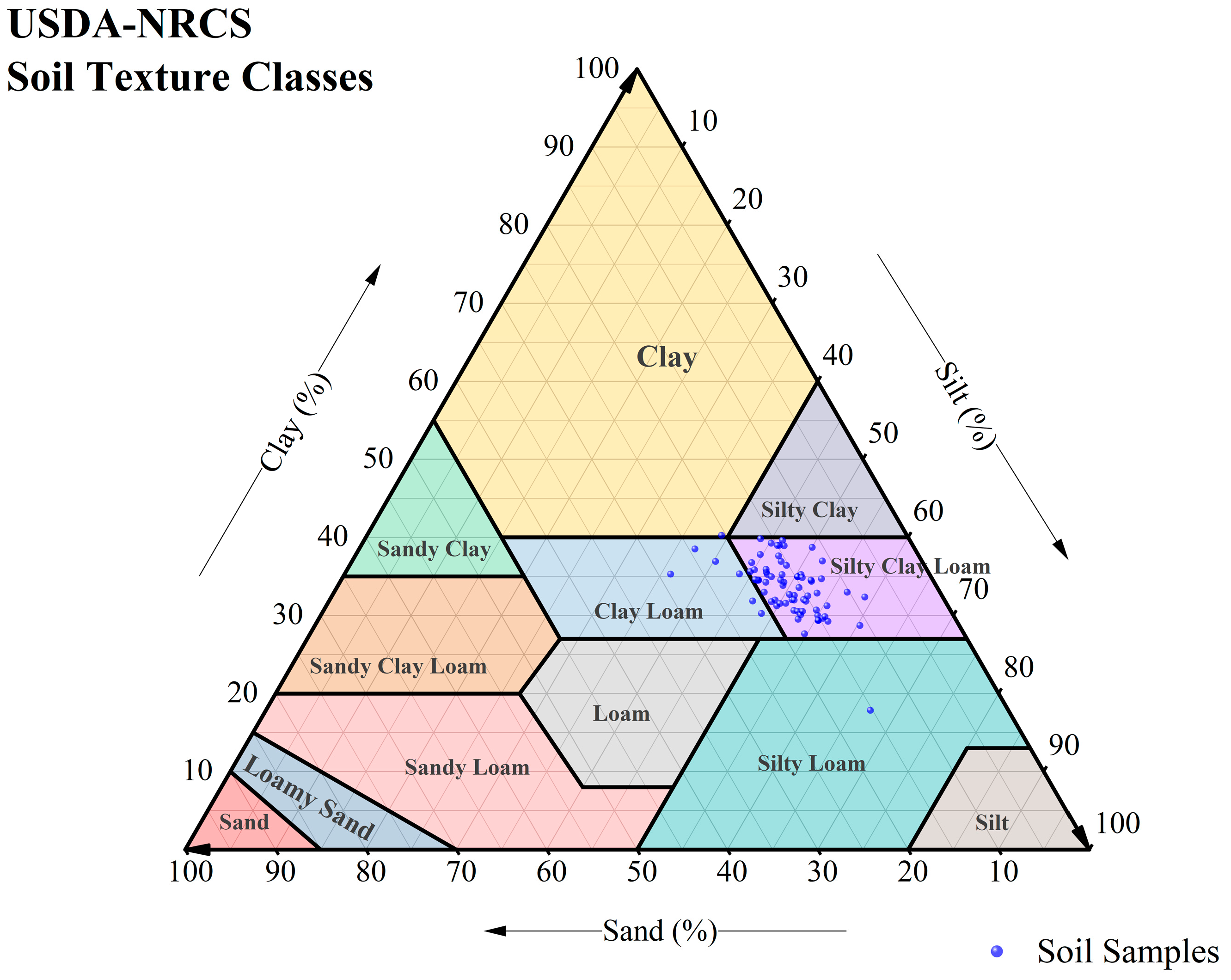


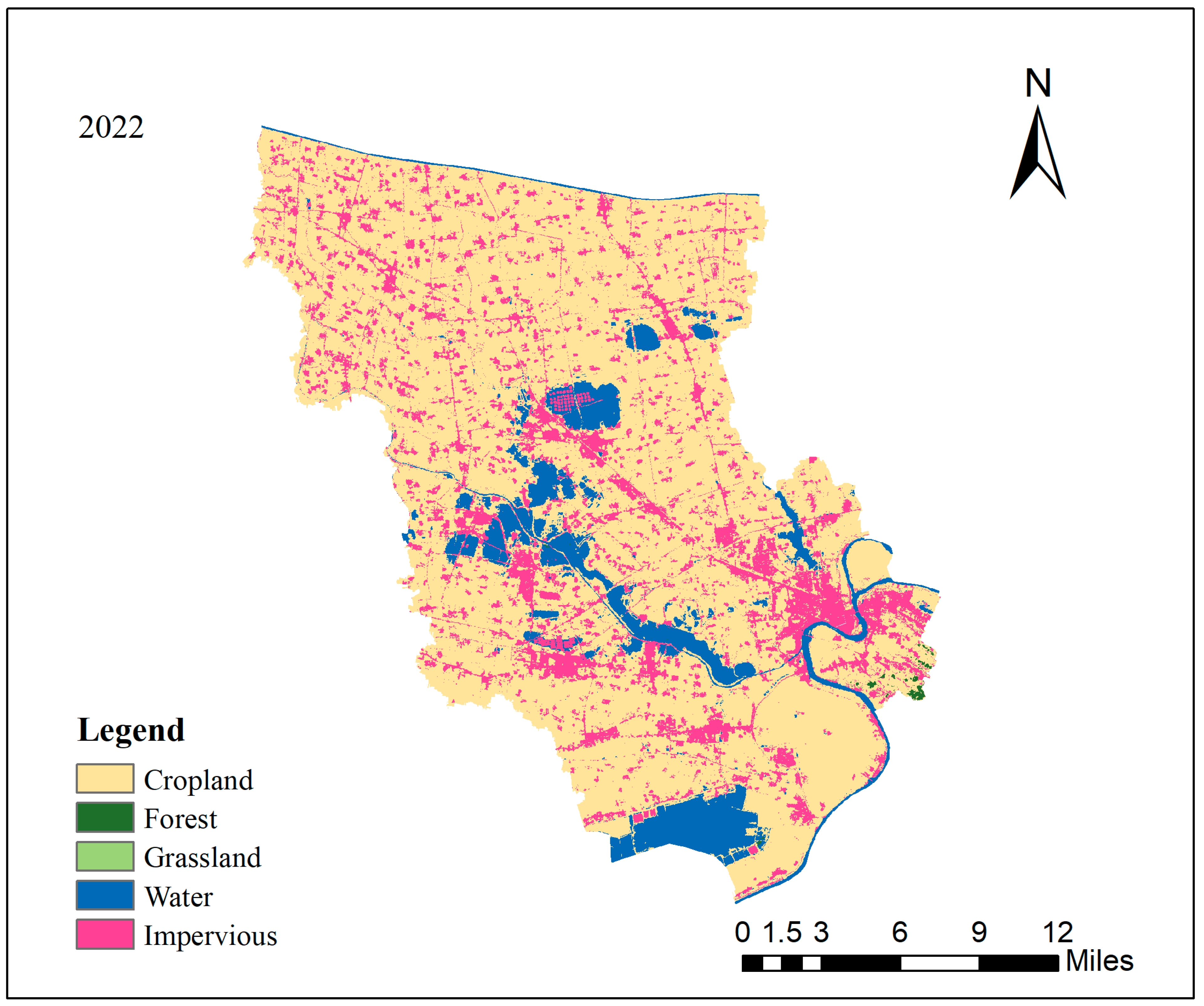

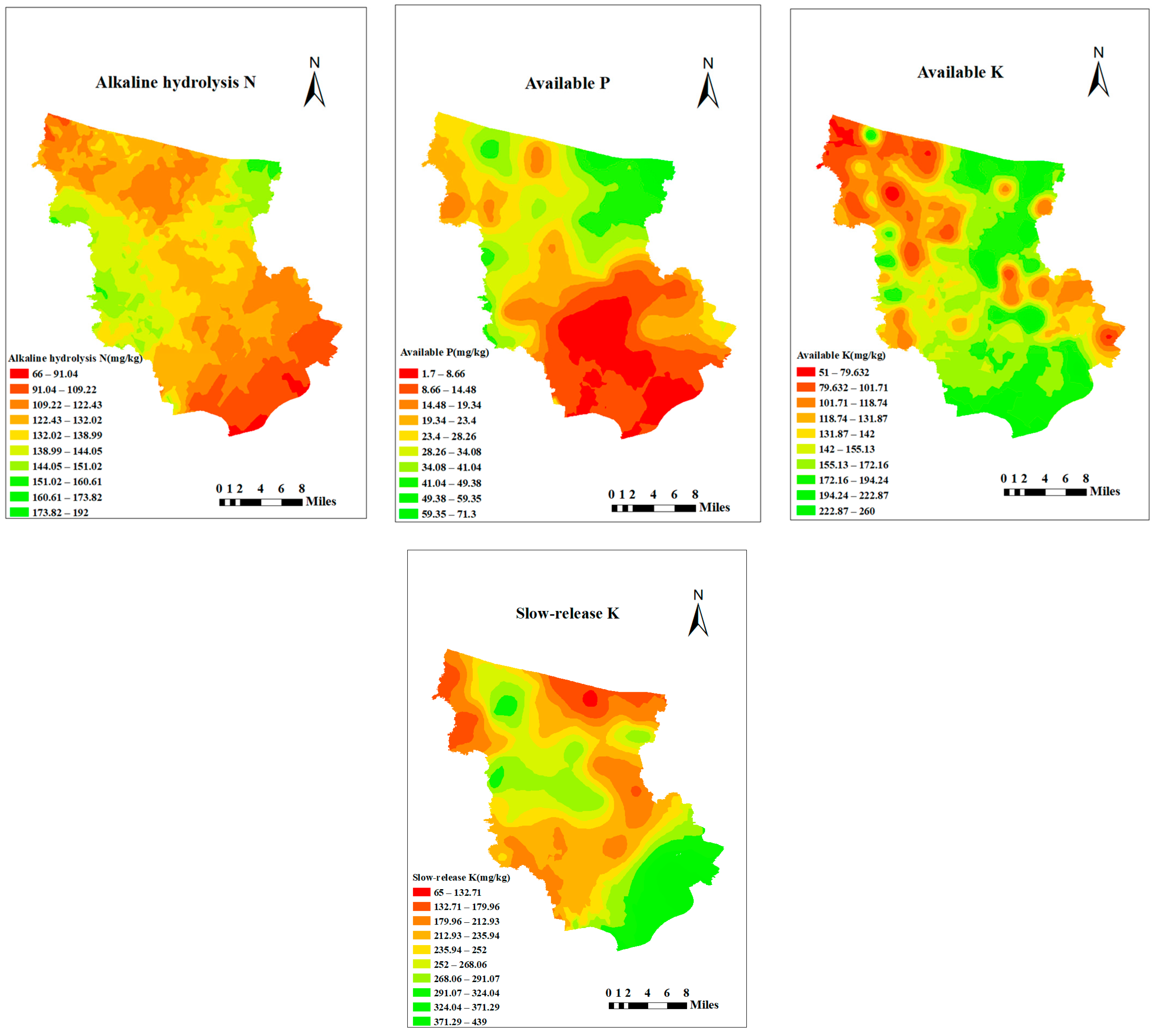
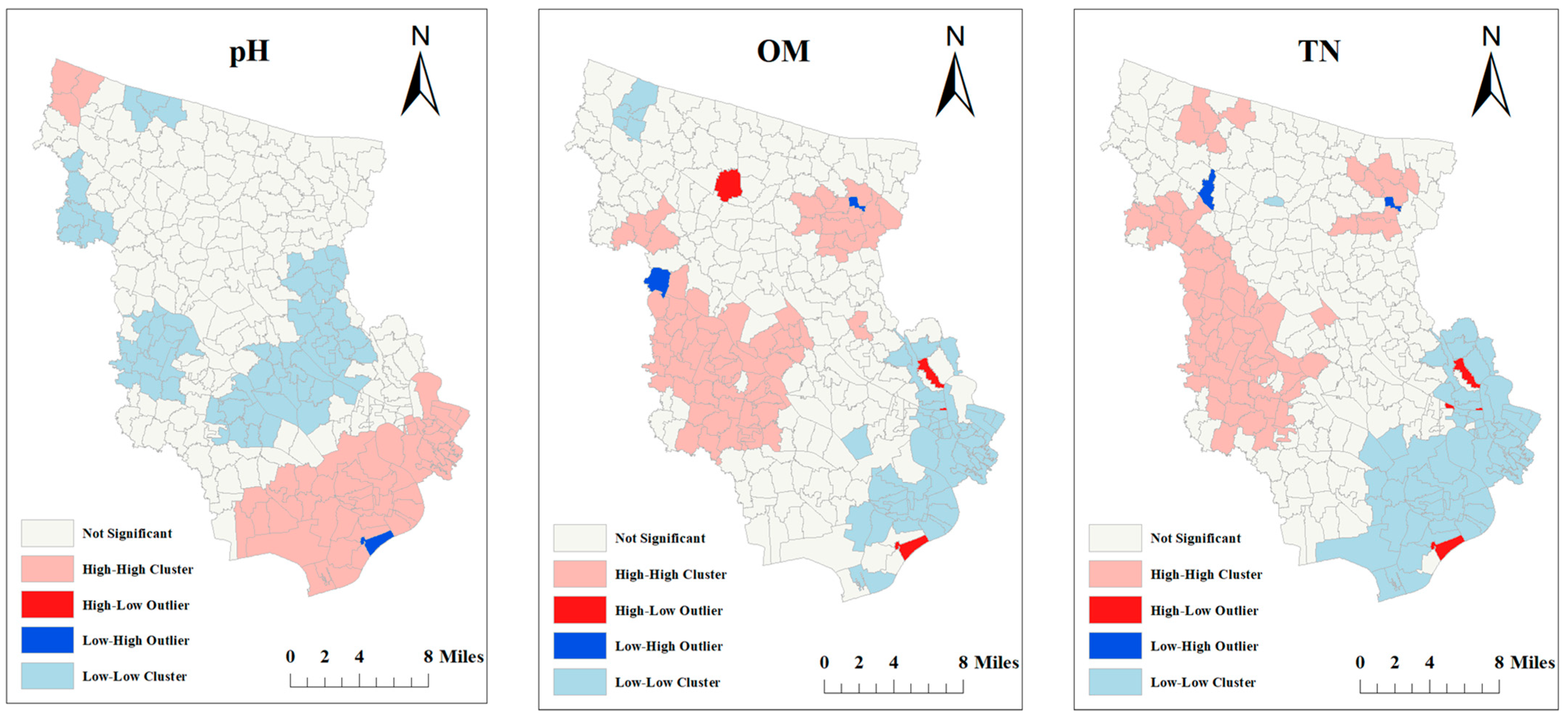
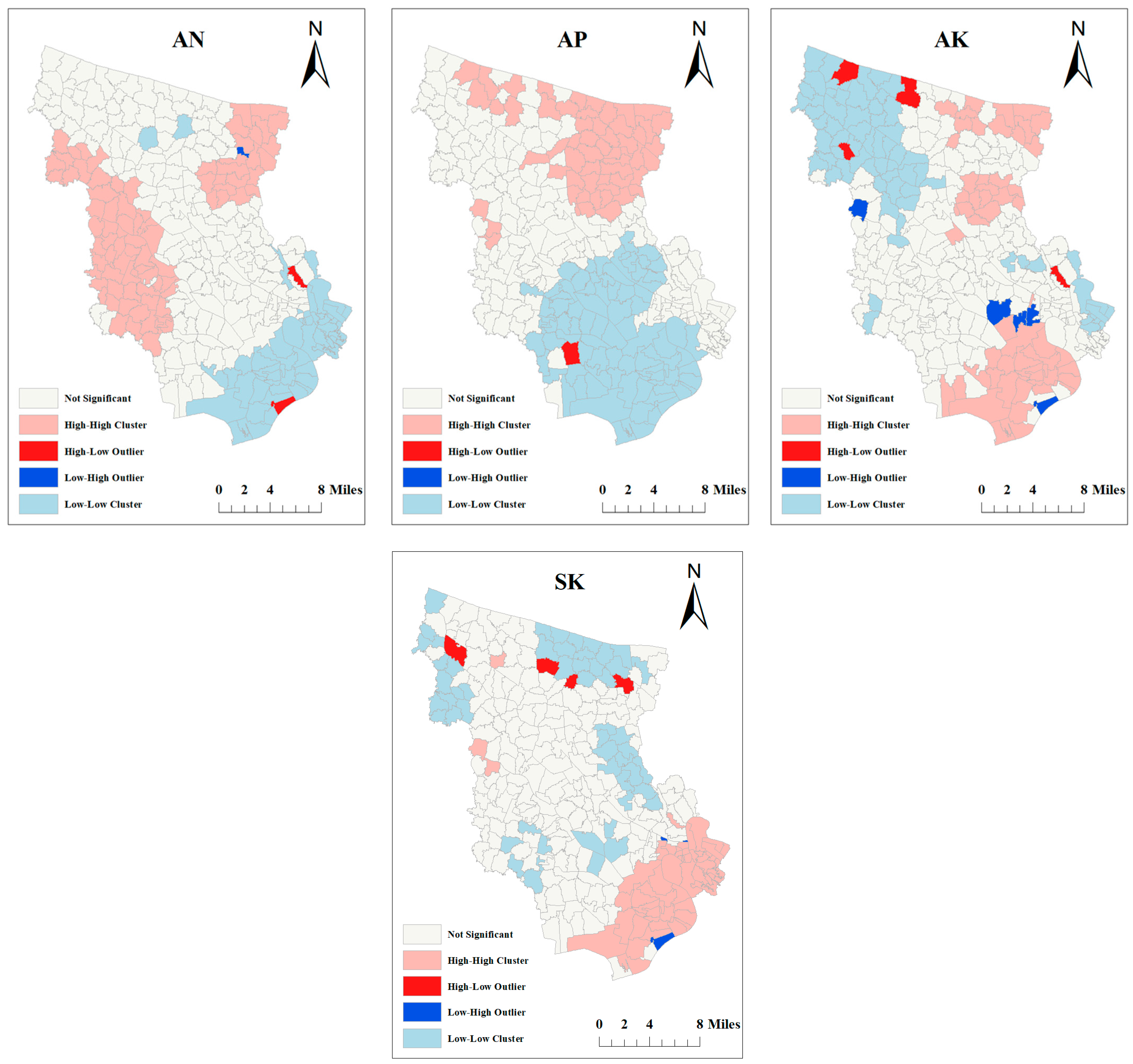
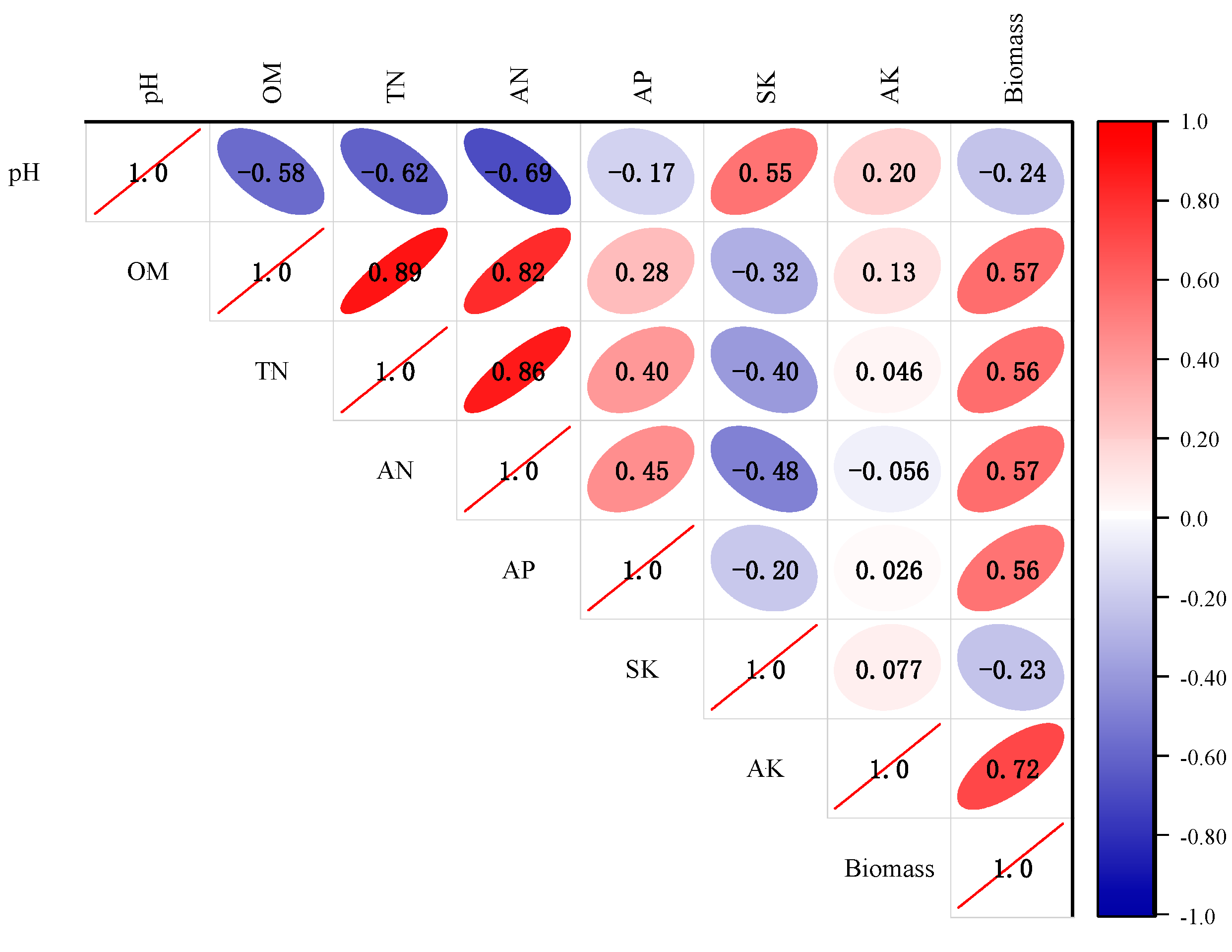


| Level | Depth (cm) | Sand (%) | Silt (%) | Clay (%) | Bulk Density (g/cm3) | Porosity (%) |
|---|---|---|---|---|---|---|
| A | 0–15 | 16.58 ± 0.53 a | 33.61 ± 0.66 a | 49.82 ± 1.53 d | 1.32 ± 0.012 b | 41.46 ± 0.08 c |
| B1 | 15–30 | 19.03 ± 0.51 b | 34.65 ± 0.71 b | 46.32 ± 1.52 a | 1.34 ± 0.009 bc | 39.25 ± 0.07 a |
| B2 | 30–53 | 16.90 ± 0.55 a | 35.58 ± 0.63 c | 47.52 ± 1.47 b | 1.31 ± 0.011 a | 41.17 ± 0.08 bc |
| C | 53–100 | 16.59 ± 0.41 a | 34.87 ± 1.07 b | 48.54 ± 1.43 c | 1.35 ± 0.010 c | 40.62 ± 0.09 b |
| Index | Min | Max | Mean | Standard Deviation | Median | CV/% | Distribution Pattern | Skewness | Kurtosis |
|---|---|---|---|---|---|---|---|---|---|
| pH | 5.03 | 8.20 | 6.68 | 0.55 | 6.72 | 8.22% | Normal Distributions | 0.10 | 3.71 |
| Organic matter | 7.40 | 40.13 | 25.04 | 5.27 | 25.54 | 21.04% | Normal Distributions | −0.53 | 4.19 |
| Total N | 0.68 | 2.96 | 1.51 | 0.31 | 1.56 | 20.53% | Normal Distributions | 0.44 | 6.79 |
| Alkalihydrolyzed Nitrogen | 66.07 | 192.73 | 129.88 | 25.26 | 134.51 | 19.45% | Normal Distributions | −0.39 | 2.77 |
| Olsen-P | 1.70 | 71.31 | 28.96 | 17.12 | 26.00 | 59.12% | Log-normal distribution | 0.43 | 2.39 |
| Available K | 51.13 | 260.45 | 141.94 | 49.11 | 137.23 | 34.59% | Log-normal distribution | 0.37 | 2.21 |
| Slowly released K | 65.04 | 439.27 | 238.33 | 71.75 | 238.69 | 30.11% | Log-normal distribution | 0.36 | 3.30 |
| Index | Model | Prediction Errors | ||||
|---|---|---|---|---|---|---|
| Mean | Root Mean Square | Standardized Mean | Root Mean Square Standardized | Average Standard Error | ||
| pH | Spherical | −0.01486 | 0.49547 | −0.02231 | 1.07578 | 0.45501 |
| Exponential | −0.01660 | 0.49438 | −0.02687 | 1.06123 | 0.46129 | |
| Gaussian | −0.01398 | 0.49290 | −0.02102 | 1.06155 | 0.45639 | |
| Organic matter | Spherical | 0.03403 | 5.52434 | 0.00731 | 1.04684 | 5.24727 |
| Exponential | 0.04402 | 5.49941 | 0.00806 | 1.03933 | 5.26406 | |
| Gaussian | 0.04073 | 5.53159 | 0.00802 | 1.04781 | 5.24555 | |
| Total N | Spherical | 0.00416 | 0.31891 | 0.01352 | 1.01581 | 0.31135 |
| Exponential | 0.00468 | 0.31363 | 0.01406 | 0.99518 | 0.31136 | |
| Gaussian | 0.00483 | 0.31429 | 0.01464 | 0.99721 | 0.31344 | |
| Alkali-hydrolyzed Nitrogen | Spherical | 0.43161 | 25.98351 | 0.01541 | 0.99525 | 26.1469 |
| Exponential | 0.42032 | 26.09732 | 0.01515 | 0.99795 | 26.17411 | |
| Gaussian | 0.42087 | 26.07551 | 0.01517 | 0.99778 | 26.16108 | |
| Olsen-P | Spherical | −0.01031 | 15.34283 | 0.00075 | 1.02757 | 14.84871 |
| Exponential | −0.01860 | 15.37351 | 0.00037 | 1.03215 | 14.83651 | |
| Gaussian | −0.06999 | 15.39364 | −0.00312 | 1.03016 | 14.86627 | |
| Available K | Spherical | 0.00315 | 45.63573 | 0.00331 | 0.99972 | 45.06263 |
| Exponential | 0.61080 | 46.35305 | 0.01352 | 1.01579 | 45.35491 | |
| Gaussian | −0.02717 | 45.92718 | 0.00309 | 1.02823 | 44.09285 | |
| Slowly released K | Spherical | −0.09869 | 57.64919 | 0.00093 | 1.00379 | 57.30993 |
| Exponential | 0.08808 | 56.98518 | 0.00298 | 0.98078 | 57.87014 | |
| Gaussian | −0.60303 | 57.67448 | −0.00651 | 0.99826 | 57.64336 | |
| Index | Model | Nugget (C0) | Still (C0 + C) | Nugget/Still C0/(C0 + C) | Range (km) | Moran’s I | Standard Z Value |
|---|---|---|---|---|---|---|---|
| pH | Gaussian | 0.236 | 0.255 | 0.926 | 0.165 | 0.871 | 24.962 |
| Organic matter | Spherical | 22.80 | 25.59 | 0.891 | 0.462 | 0.682 | 19.563 |
| Total N | Spherical | 0.117 | 0.119 | 0.988 | 0.415 | 0.783 | 22.464 |
| Alkalihydrolyzed Nitrogen | Exponential | 412.0 | 412.9 | 0.998 | 0.777 | 0.876 | 25.095 |
| Olsen-P | Exponential | 266.3 | 311.1 | 0.856 | 0.756 | 0.884 | 25.353 |
| Available K | Spherical | 941.2 | 1311 | 0.718 | 0.199 | 0.562 | 16.136 |
| Slowly released K | Exponential | 3670 | 3772 | 0.973 | 0.237 | 0.729 | 20.921 |
| Ingredient | pH | SOM | TN | AN | AP | SK | AK |
|---|---|---|---|---|---|---|---|
| PC1 | −0.679 | 0.905 | 0.934 | 0.919 | 0.523 | −0.499 | 0.188 |
| PC2 | 0.535 | 0.026 | −0.068 | −0.214 | 0.118 | 0.477 | 0.860 |
Disclaimer/Publisher’s Note: The statements, opinions and data contained in all publications are solely those of the individual author(s) and contributor(s) and not of MDPI and/or the editor(s). MDPI and/or the editor(s) disclaim responsibility for any injury to people or property resulting from any ideas, methods, instructions or products referred to in the content. |
© 2024 by the authors. Licensee MDPI, Basel, Switzerland. This article is an open access article distributed under the terms and conditions of the Creative Commons Attribution (CC BY) license (https://creativecommons.org/licenses/by/4.0/).
Share and Cite
Jiang, Z.; Yin, Z.; Li, X.; Chen, D.; Huang, M.; Zhou, Y.; Wu, T.; Zhao, M.; Wang, W.; Zhang, Y. Spatial Heterogeneity of Soil Nutrient in Principal Paddy and Cereal Production Landscapes of Fengtai County within the Huai River Basin, Eastern China. Appl. Sci. 2024, 14, 9087. https://doi.org/10.3390/app14199087
Jiang Z, Yin Z, Li X, Chen D, Huang M, Zhou Y, Wu T, Zhao M, Wang W, Zhang Y. Spatial Heterogeneity of Soil Nutrient in Principal Paddy and Cereal Production Landscapes of Fengtai County within the Huai River Basin, Eastern China. Applied Sciences. 2024; 14(19):9087. https://doi.org/10.3390/app14199087
Chicago/Turabian StyleJiang, Zhiyang, Zheng Yin, Xinbin Li, Daokun Chen, Meiqin Huang, Yuzhi Zhou, Tingsen Wu, Mingze Zhao, Wenshuo Wang, and Yupeng Zhang. 2024. "Spatial Heterogeneity of Soil Nutrient in Principal Paddy and Cereal Production Landscapes of Fengtai County within the Huai River Basin, Eastern China" Applied Sciences 14, no. 19: 9087. https://doi.org/10.3390/app14199087







